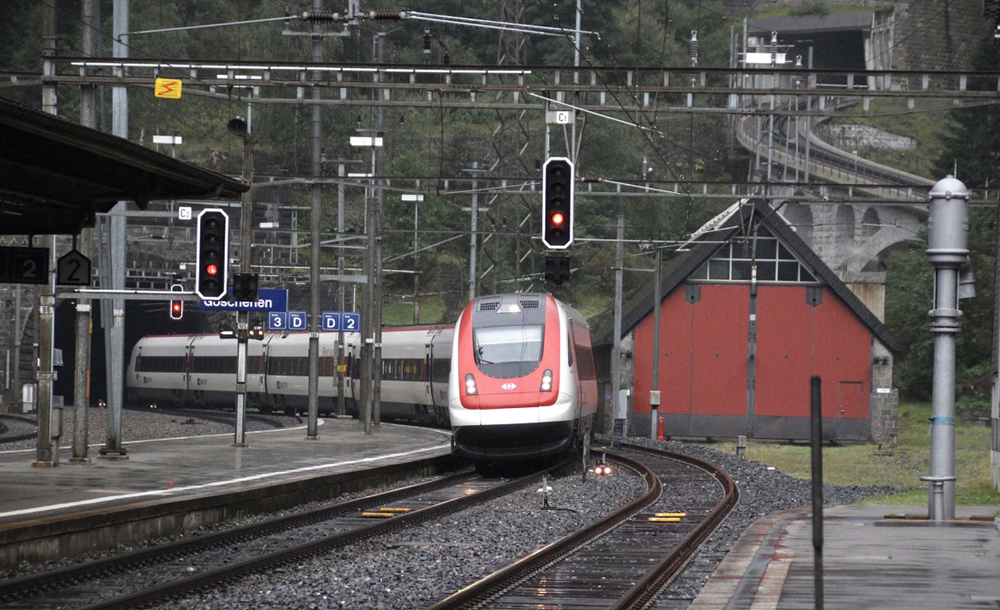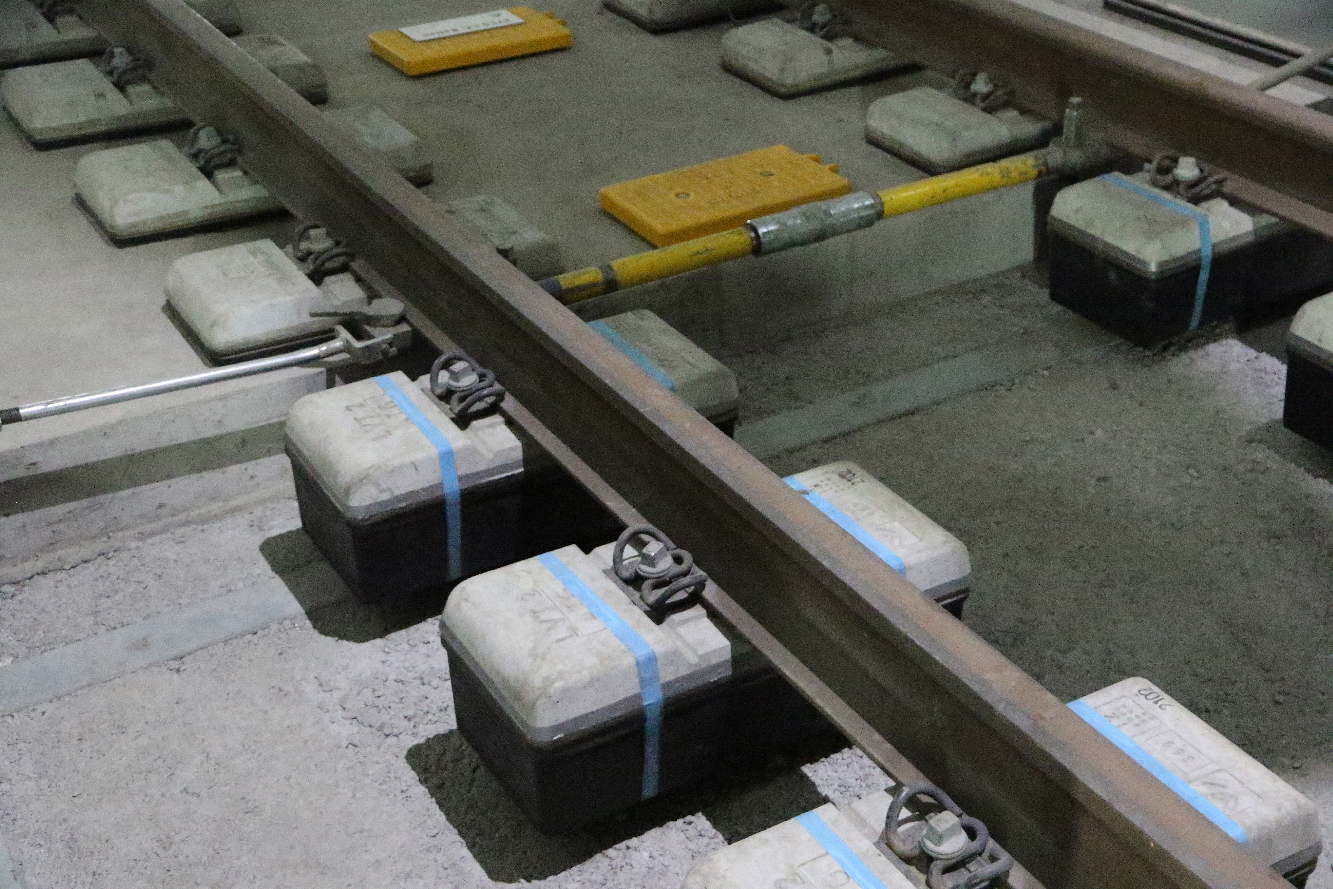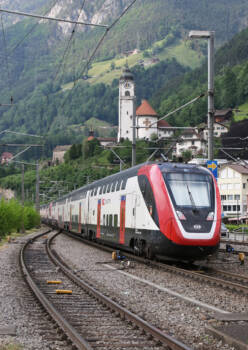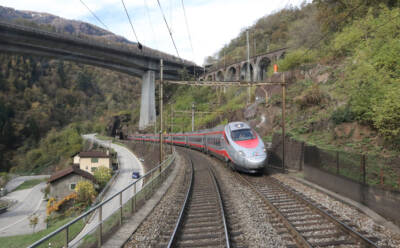
With remarkable timing — the process had been underway for years — but the Gotthard Base Tunnel derailment may have convinced any remaining doubters, the Swiss government announced on Aug. 16, a week after the tunnel was shut following a derailment, that it had approved the completion of the other major Swiss alpine rail crossing the Lötschberg Base Tunnel as double track throughout.
This 34.7km- (21.7 miles) long tunnel on the line between Swiss capital Berne and Brig opened in 2007, but due to cost increases (and the need to fund the Gotthard Base Tunnel) was never completed as a two-track railway. Whilst both ends of the tunnel are double track and the eastern bore is complete, around 6km (3.75 miles) of the western bore was never built and another 14km (8.75 miles) of it was left as an uncompleted shell. A separate connecting tunnel enabling trains to head west towards Lausanne/Geneva at the southern end was also left as a raw built shell and not equipped with rail infrastructure.
The decision to finish off the Lötschberg Base Tunnel is part of the “Bahn 2050” program that has been under development for several years and includes several other major infrastructure upgrades. Assuming funding is available Lötschberg Base Tunnel Infrastructure owner BLS is planning to start work to complete the tunnel in 2026 and finish in 2033.
French mountain tunnel closure puts more pressure
The Gotthard Base Tunnel was shut by the derailment on August 10 [see “Derailment closes Switzerland’s Gotthard Base Tunnel,” News Wire, Aug. 10, 2023] setting off a scramble to re-route trains, especially those loaded with tall truck trailers, which cannot pass over the older Gotthard-mountain line. The Lötschberg Base Tunnel was the first choice but, as described, it has limited capacity due to being partly single track. The other alternative route via the Brenner Pass in neighboring Austria was shut for summer maintenance work, leaving freight traffic to either back up waiting for a path through Switzerland or detour much further to either eastern Austria taking the route via Villach, Austria, and Tarvisio, Italy, entering Italy north of Venice or heading much further west to the route through the French Alps via the Frejus Pass and tunnel entering Italy in the west near Turin.
The maintenance closure of the Brenner route ended on Aug. 23, just as the Gotthard Base Tunnel reopened one tube for freight trains [see “One tube of Gotthard Base Tunnel reopens for freight traffic,” News Wire, Aug. 23, 2023], but days later on Aug. 27, major landslides between Saint Jean-de Maurienne and Modane closed the Frejus Pass rail and motorway routes between France and Italy. That railway is likely to be shut for some months and despite the current problems in Switzerland will lead to more traffic via the Swiss transit routes. Due to the closure there are also currently no international passenger trains between Paris and Italian cities.
Gotthard repairs get underway as alternate passenger service introduced

The Gotthard Base Tunnel was built with a fixed low vibration track system literally set in concrete with a 60 year design life before renewal is required. The track was laid between 2010 and 2014 using 120-meter (131 yard) lengths welded together on site. The rails are mounted on small sleepers using fasteners supplied by Vossloh. The small concrete sleepers are themselves are mounted on rubber blocks with a 1cm- (0.4 inch) thick rubber mat in between the sleeper and the rubber block. [the picture supplied shows exactly how this is done] and the sleepers are then set in concrete. The concrete base effectively guarantees the tracks do not move apart — unlike conventional ties the small concrete sleepers are not connected to each other on either side of the track. Construction for the slab track was based on the use of a specialist cement manufacturing train to pour the concrete at the rate of around 200 metres (219 yards) a day, building 2km (1.25 miles) of line at a time, although it was entirely hand finished.
Unfortunately the accident has resulted in the need for extensive repairs to around 8km (5 miles) of the tunnel, which will involve removing the concrete base and sleepers for most or all of the affected section, levelling the trackbed, and rebuilding the track system using a similar process to the original construction once materials and components have been obtained, which may delay repairs as some of the components are not readily available in the quantities required but have to be manufactured. Once the track has been re-laid and the concrete has cured work to reinstate overhead electrification, signalling detection systems and the new doors for the Faido crossover facility can begin. Tunnel owner and operator Swiss Railways, SBB, is currently predicting limited use of both tunnels by “early 2024.”
While repair work is underway, the old Gotthard-mountain route is being used for freight and passenger diversions with freight having sole use of the line overnight from 11 p.m. to 5 a.m. and passenger trains having majority use in between those times with only one freight path scheduled each way. Freight trains with vehicles or loads using the latest European 4-meter “corner height” structure gauge permitted in the Gotthard Base Tunnel cannot use the old route nor can SBB’s bilevel passenger Intercity trains or EMUs so changes in operations have been made. Longer journey times mean more passenger equipment is needed for hourly- and half-hourly interval timetables, so most international trains are now running as separate trains in Switzerland and Italy.

Passenger trains between the southern canton of Ticino and central Swiss cities are being mostly operated using SBB single deck ‘ICN’ and newer Giruno EMUs via the mountain route albeit with journey times of an hour or more longer than before; some older locomotive-hauled sets have also been drafted into service on the route. Almost all international express services between Switzerland and Italy have stopped running with passengers now required to change train in Chiasso at the border although direct services from Zurich to both Genoa and Venice remain.
Subhead More base tunnels being built under the Alps
Although the Swiss Gotthard and Lötschberg base tunnels have been in use for several years and are heavily travelled by freight traffic from northern Europe to Italy and southeastern Europe, other base-tunnel routes are being developed connecting Italy with its neighbors Austria and France. The new base tunnels, which should be open within the next decade, will offer faster transit times and the ability to operate longer and taller trains compared to the older routes currently in use.
Between Austria and northern Italy, a 64km- (40 mile) long base tunnel under the Brenner Pass route is now partially complete and likely to open in the early 2030s. Major investment is planned in Italy and Germany to build additional approach tracks to this new route.

On the easternmost route from Austria to Italy two new base tunnels are being built in Austria between Vienna and Villach; one due to open in 2030 running for 27.3km (17 miles) long under the famous Semmering route. This was the first main line railway over mountains built in Europe opening in 1854. Further south another tunnel is now nearly ready for use under the Koralpe mountains south of Graz; the Koralm Tunnel is 33km (20.6 miles) long and forms part of a new 130km (81 mile) long, 250km/h (156 mph) rail line between Graz and Klagenfurt due to open in 2026. When complete these new tunnels will offer a more direct, flatter route between the Vienna region and the Italian border at Tarvisio. A significant portion of the Italian route has already been rebuilt with new tunnels and gentler curves.
In August a contract was awarded worth €1.1 billion (U.S.$1.2 billion) for boring and construction of the tunnel system on the 14.25km- (8.1 mile) long Italian section of the planned 57.5km- (35.1 mile) long, 220km/h (137 mph), Mont Cenis Base Tunnel on the route between Turin, Italy, and Lyon, France. Current plans are for the new tunnel to be complete around 2032. Construction contracts for the longer sections of the tunnel in France have already been negotiated and around a third of the 115km (72 miles) total tunnelling required (mainly access routes and preparatory work) has already been done.














The current situation at the Gotthard is that, as stated, all passenger trains are lead over the old Panoramic Route, and take an hour longer than through the tunnel. Eurocities to Milano are now running through, no longer requiring a change of trains at the border.
Also, as stated, about 30 freight trains per direction can be sent over the old panoramic route.
The Eastern bore of the base tunnel is open for freight, and they send them in bundles of 4 through it, then changing direction. This leads to about 90 paths per day in total. This is approximately half the regular freight capacity of the tunnel.
Source: Press Releases by Swiss Federal Railways.